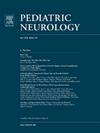Exploring the Efficacy and Safety of Vagus Nerve Stimulation for the Treatment of Epilepsy in Patients With Sturge-Weber Syndrome: A Pilot Study
IF 3.2
3区 医学
Q2 CLINICAL NEUROLOGY
引用次数: 0
Abstract
Background
Sturge-Weber syndrome (SWS) is a rare congenital neurocutaneous disorder, often complicated by epilepsy. Approximately 50% of patients with SWS with epilepsy develop drug-resistant seizures, leaving limited treatment options. Vagus nerve stimulation (VNS) is a known therapy for refractory epilepsy, modulating neural activity to reduce seizures. This study examines the therapeutic outcomes, efficacy, and safety of VNS in five patients with SWS suffering from epilepsy.
Methods
A retrospective analysis of VNS treatment data from January 2021 to January 2022 in patients with SWS was conducted. Preoperative assessments included neuroimaging and video-electroencephalography monitoring. Cognitive function and quality of life were assessed using age-appropriate scales. VNS settings and seizure outcomes were recorded at different follow-up intervals. Seizure outcomes were classified using the modified Engel and McHugh classification. Cognitive function and quality of life were reassessed at two-year follow-up.
Results
Five patients, primarily pediatric, with seizure onset between age 0.5 and eight years, were included. After VNS therapy, all patients experienced a reduction in seizure frequency, with one patient becoming seizure free and three achieving a ≥50% reduction in seizures. Two children with cognitive impairments at baseline demonstrated cognitive improvements following treatment. All patients reported significant enhancements in quality of life. VNS was well tolerated, with no major adverse events reported.
Conclusions
VNS offers promising therapeutic benefits for epilepsy in patients with SWS, reducing seizure frequency, improving cognitive function in children, and enhancing quality of life with a favorable safety profile. Further research with larger sample sizes and control groups is warranted to validate efficacy and explore personalized treatment options.
探索迷走神经刺激治疗斯特奇-韦伯综合征癫痫患者的有效性和安全性:一项初步研究。
背景:斯特奇-韦伯综合征(SWS)是一种罕见的先天性神经皮肤疾病,常并发癫痫。大约50%伴有癫痫的SWS患者会出现耐药癫痫发作,因此治疗选择有限。迷走神经刺激(VNS)是一种已知的治疗顽固性癫痫,调节神经活动,以减少癫痫发作。本研究考察了VNS对5例癫痫伴SWS患者的治疗效果、疗效和安全性。方法:回顾性分析2021年1月至2022年1月SWS患者的VNS治疗数据。术前评估包括神经影像学和视频脑电图监测。认知功能和生活质量采用与年龄相适应的量表进行评估。在不同的随访时间间隔记录VNS设置和癫痫发作结果。癫痫发作结果采用改良的Engel和McHugh分类。在两年的随访中重新评估认知功能和生活质量。结果:纳入了5例患者,主要是儿童,癫痫发作年龄在0.5岁至8岁之间。经VNS治疗后,所有患者癫痫发作频率均有所降低,其中1例患者无癫痫发作,3例患者癫痫发作减少≥50%。两名基线认知障碍儿童在治疗后表现出认知改善。所有患者都报告了生活质量的显著提高。VNS耐受性良好,无重大不良事件报道。结论:VNS对SWS癫痫患者具有良好的治疗效果,可减少癫痫发作频率,改善儿童认知功能,提高生活质量,并具有良好的安全性。进一步的研究需要更大的样本量和对照组来验证疗效并探索个性化的治疗方案。
本文章由计算机程序翻译,如有差异,请以英文原文为准。
求助全文
约1分钟内获得全文
求助全文
来源期刊

Pediatric neurology
医学-临床神经学
CiteScore
4.80
自引率
2.60%
发文量
176
审稿时长
78 days
期刊介绍:
Pediatric Neurology publishes timely peer-reviewed clinical and research articles covering all aspects of the developing nervous system.
Pediatric Neurology features up-to-the-minute publication of the latest advances in the diagnosis, management, and treatment of pediatric neurologic disorders. The journal''s editor, E. Steve Roach, in conjunction with the team of Associate Editors, heads an internationally recognized editorial board, ensuring the most authoritative and extensive coverage of the field. Among the topics covered are: epilepsy, mitochondrial diseases, congenital malformations, chromosomopathies, peripheral neuropathies, perinatal and childhood stroke, cerebral palsy, as well as other diseases affecting the developing nervous system.
 求助内容:
求助内容: 应助结果提醒方式:
应助结果提醒方式:


